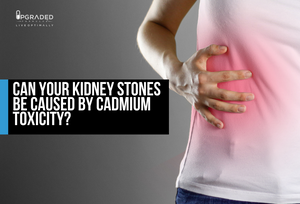Can Cadmium Toxicity cause Your Kidney Stones?
Introduction
Kidney Stones: The Unwelcome Guests Within. Far from being a trivial annoyance, kidney stones are a source of intense pain and discomfort, striking as foreign invaders in the delicate ecosystem of our bodies.
Rather than a natural anatomy component, they represent the unwanted accumulation of substances our systems are ill-equipped to handle. Be it due to inadequate detoxification or the insidious influence of pollutants like heavy metals, these crystalline formations, also known as small stones, can cause significant health challenges, including complications such as kidney disease and blocking the flow of urine.
In some cases, a large stone may get stuck in the urinary system, causing even more severe pain and complications, requiring treatment such as stone pass, laparoscopic surgery, or open surgery.
In this exploration, we delve into the origins of kidney stones, examining the intricate processes behind their formation. Along the way, we'll uncover potential culprits that often escape medical scrutiny, including cadmium toxicity.
Join us as we embark on a journey to understand better these painful interlopers and the hidden factors contributing to their unwelcome presence. We'll also discuss the role of your healthcare provider in diagnosing and treating kidney stones caused by cadmium toxicity, including significant diet changes and treatment options that may be necessary.
Your healthcare provider will perform a physical exam and blood tests to diagnose and treat kidney stones and check your kidney function, so it is essential to seek medical attention if you suspect you may have them.
Understanding Kidney Stones and Their Impact
The kidneys are silent but pivotal heroes in the narrative of our health, performing a symphony of functions essential for a harmonious body:
Essential Toxin Filters
Acting as vigilant gatekeepers, our kidneys constantly sift through blood, bidding farewell to waste products, toxins, and any surplus of salts and water, which are then ushered out of the body through urine.
Masters of Fluid Balance
Like skilled alchemists, kidneys meticulously regulate the balance of bodily fluids and the spectrum of electrolytes—including sodium, potassium, and calcium—while also ensuring our internal pH stays finely tuned for optimal cellular activity.
Blood Pressure Regulators
Commanding the ebb and flow of blood pressure, kidneys intricately adjust blood volume and dispatch the hormone renin, orchestrating the delicate dance of blood vessel constriction and fluid regulation.
Hormone Factories
Beyond their filtering finesse, kidneys are also adept hormonal artisans. They craft vital substances such as erythropoietin to spawn fresh red blood cells and calcitriol, an active vitamin D derivative, reinforcing calcium levels and bolstering our bones.
Acid-Base Harmonizers
Navigating the acid-base balance, kidneys work tirelessly, trading hydrogen ions and retrieving bicarbonate to maintain the blood’s pH within the prime range necessary for life.
Detoxifiers
Beyond their filtration forte, kidneys also act as detoxifying agents, breaking down and banishing medicinal residues, environmental toxins, and unwanted foreign elements.
Guardians of Oxygen Transport
By stimulating the production of red blood cells through erythropoietin, kidneys ensure our cells never thirst for oxygen, which is vital for survival.
Turning to kidney stones, these unwelcome crystalline accumulations of minerals and salts take form within the kidneys. These stones are as varied in type as they are in size – from microscopic specks to obstructions as large as pebbles.
Types of Kidney Stones
Calcium Stones
Often stepping into the spotlight, these calcium oxalate stones are frequent culprits, born from a substance common in our diets.
Struvite Stones
Born out of infection, these rapidly expanding stones bear witness to the conflicts within.
Uric Acid Stones
Fashioned in an overly acidic urinary milieu, these stones trace their lineage to dietary choices and hereditary threads.
Cystine Stones
A rare breed, these result from a genetic legacy leading to an excessive expulsion of specific amino acids.
Each stone, regardless of its kind, harbors the potential for immense discomfort, manifesting as a gauntlet of symptoms from excruciating pain to the unsettling hue of blood in urine. Our quest is not merely to explore the nature of these stones but to understand them— to prevent, manage, and conquer, especially when it comes to cystine stones, which can be diagnosed through imaging tests such as CT scans, urine tests, and intravenous pyelogram. These stones can cause the main symptom of severe pain in the lower back, which can be treated with shock waves through a procedure called Shock Wave Lithotripsy (SWL).
Common Causes and Risk Factors for Kidney Stones
The formation of kidney stones is an intricate process that occurs when substances like calcium, oxalate, and uric acid attain excessive concentrations in urine, crystallizing into solid units.
Understanding the precise causative factors can be intricate due to the variety of stone types. Still, there are common contributors to their development, including having high calcium levels in the urine, a condition known as hypercalciuria.
This can be caused by several factors, such as excessive calcium absorption from the intestines or bones. Other common causes and risk factors for kidney stones include dehydration, obesity, and certain medical conditions such as renal calculi.
Hydration Deficiency
Inadequate fluid intake can increase urine concentration, escalating the risk of kidney stone formation. To prevent such scenarios, optimal hydration, which aids in diluting the stone-forming substances in urine, is critical.
Dietary Contributions
Certain high-oxalate foods, including spinach, nuts, chocolate, and some fruits, can potentially lead to the development of calcium oxalate stones. Likewise, diets rich in protein, sodium, and sugar may escalate the risk of stone formation.
Genetic Influence
Some individuals have an inherent predisposition towards developing kidney stones. Specific genetic conditions affecting the body's processing of substances like calcium or cystine may enhance the risk of stone creation.
Health Conditions
Various medical conditions or procedures, including urinary tract infections, inflammatory bowel disease, obesity, and metabolic disorders like hyperparathyroidism or gout, can elevate our susceptibility to kidney stones.
Medicinal Impact
Certain medications can inadvertently spark kidney stones' development by altering the urine's composition. These can include diuretics, calcium-based antacids, and specific drugs utilized to combat HIV or AIDS.
Anatomical Influences
Structural abnormalities in the urinary system, such as ureteral constriction or abnormally shaped kidneys, can encourage stone formation.
Past Episodes
Those who have weathered kidney stones previously face an increased likelihood of recurrent episodes.
Understanding these factors helps manage kidney stone episodes and informs preventative measures, shielding our bodies from these painful intruders.
Symptoms of Kidney Stone
Kidney stone symptoms can significantly vary, influenced by the stone's size, its precise location in the urinary tract, and whether it obstructs urinary flow. Typical symptoms exhibited by those with kidney stones include:
Intense Pain
A primary indicator of kidney stones is severe discomfort, usually localized to the back, side, lower abdomen, or groin. The pain, characterized as sharp or akin to stabbing, may fluctuate in intensity.
Discomfort During Urination
Individuals may encounter notable distress when urinating, which might manifest as a burning sensation or acute pain.
Visible Blood in Urine
Kidney stones can introduce blood into the urine, altering its color to shades of pink, red, or even brown, a condition medically referred to as hematuria.
Increased Urination Urges
There may be a more frequent need to urinate, with minimal urine excretion each time.
Nausea and Vomiting
The extreme discomfort caused by kidney stones can lead to feelings of nausea or even vomiting.
Fever and Chills
Individuals may experience fever accompanied by chills, signifying a potentially grave complication, such as an infection or a urinary flow blockage due to a stone, necessitating immediate medical attention.
Urinary Retention
In cases where a stone obstructs urine flow, there could be difficulty in urinating or an inability to urinate.
Changes in Urine Quality
Kidney stones may alter the appearance and scent of urine, potentially resulting in cloudy urine or an unpleasant odor indicative of infection or the presence of blood.
Recognizing these symptoms is vital for timely diagnosis and treatment, mitigating the discomfort and preventing further complications associated with kidney stones.
Cadmium Toxicity as an Environmental Factor in Kidney Stone Formation
Contrary to the belief that diet and genetics predominantly influence kidney stone formation, a growing body of research suggests that cadmium toxicity can significantly impact our mineral status, affecting calcium metabolism and consequently leading to stone formation.
This is quite paradoxical as these stones arise from calcium itself. Maintaining a healthy weight and consuming foods high in dietary calcium can help prevent kidney stones, while taking calcium supplements or antacids with calcium may increase the risk for stone formation.
Additionally, individuals with the lowest dietary calcium intake have an increased risk of kidney stones, making prevention through diet and lifestyle choices even more crucial, including reducing sodium intake to lower the risk of calcium-containing stones.
Understanding your medical and dietary history is essential in identifying potential risk factors for kidney stone formation and developing a personalized prevention plan..
One study identified a positive correlation between kidney stones and cadmium exposure, reporting increased plasma cadmium levels in most 940 participants.
Similarly, another research paper illustrated higher instances of calcium urinary excretion, leading to kidney stone formation, among those exposed to cadmium. At the biochemical level, this occurs because cadmium, a calcium antagonist, can substitute calcium in our bodies.
Finally, an intriguing study demonstrated an association between kidney stone formation and toxicity from two heavy metals: cadmium and lead. The research found positive correlations between cadmium concentrations and patient history, specifically among individuals with a history of smoking and high calcium oxalate monohydrate levels. Conversely, cadmium concentrations were negatively associated with struvite levels and uric acid/uric acid dihydrate.
Lead concentrations were positively linked to women and apatite levels while inversely associated with uric acid/uric acid dihydrate. Upon controlling other variables like stone type composition, smoking status, and age, both heavy metals showcased a positive association with apatite and a negative correlation with uric acid/uric acid dihydrate, struvite, and calcium carbonate.
Conclusion
The evidence above underscores the intricate relationship between cadmium exposure and kidney stone formation, challenging the traditional viewpoint that diet and genetics are the sole culprits.
Studies demonstrate a clear association between increased cadmium levels and the occurrence of kidney stones, highlighting the role of environmental factors in this painful condition.
Furthermore, the biochemical mechanisms at play show cadmium's ability to disrupt calcium metabolism, emphasizing the need for broader recognition of environmental toxins as significant contributors to health issues such as kidney stones.
As individuals strive to understand and mitigate the risks associated with kidney stones, it becomes imperative to consider the broader environmental and lifestyle factors, including exposure to heavy metals like cadmium, in the quest for prevention and treatment.
This exploration opens new avenues for research and underscores the importance of holistic approaches in addressing kidney stone formation and overall kidney health.
Opting for a Hair Tissue Mineral Analysis (HTMA) is a highly beneficial approach to identifying imbalances in your body's elemental content. This comprehensive tool offers a snapshot of your mineral levels, ensuring effective overall health management.
Ready to embark on a journey towards optimal mineral balance? Schedule your HTMA with us today! If it's evident that your body requires an additional calcium boost, explore our specially formulated, enhanced, Upgraded Calcium to fulfill your needs!


